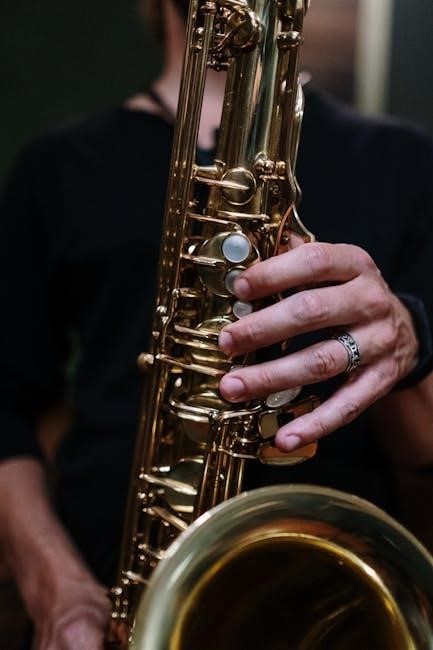The alto saxophone, invented by Adolphe Sax in 1846, is a versatile woodwind instrument widely used in jazz, classical, and popular music. Its rich, smooth tone and manageable size make it a favorite among musicians. Known for its bright yet warm sound, the alto sax is a key instrument in various ensembles. Understanding its fingering chart is essential for mastering its unique voice and extending its expressive capabilities effectively.
1.1. Brief History of the Alto Saxophone

The alto saxophone, invented by Adolphe Sax in 1846, was designed to bridge the gap between brass and woodwind instruments. Sax envisioned an instrument with the agility of woodwinds and the power of brass, leading to its unique hybrid design. Initially used in military bands and classical music, the alto sax gained prominence in the early 20th century with the rise of jazz. Its popularity soared as legendary musicians like Charlie Parker and David Sanborn showcased its expressive capabilities. Over time, the alto saxophone evolved in design, with improvements in key mechanisms and materials, solidifying its place as a cornerstone in various musical genres. Its enduring appeal lies in its versatility and distinctive voice.
1.2. Key Components of the Alto Saxophone
The alto saxophone consists of several essential parts that work together to produce its distinctive sound. The mouthpiece, where the reed is attached, is crucial for tone production. The neck connects the mouthpiece to the body, while the body houses the keys and pads that control airflow. The keys, operated by the fingers, cover or uncover the pads to alter the pitch. The bell amplifies the sound, giving the saxophone its characteristic projection. Other vital components include the octave key, which adjusts the pitch range, and the ligature, securing the reed. Understanding these parts is fundamental for using a fingering chart effectively and mastering the instrument’s unique capabilities.

What is a Fingering Chart?
A fingering chart is a visual guide showing finger placements on the alto saxophone to produce specific notes. It helps musicians master note accuracy and improve technique efficiently.
2.1. Definition and Purpose of a Fingering Chart
A fingering chart is a detailed guide that maps finger placements on the alto saxophone to specific notes. Its primary purpose is to help musicians learn and master the correct fingerings for producing clear, accurate notes. Designed for both beginners and advanced players, it visually organizes the instrument’s layout, making it easier to understand and memorize finger positions. The chart typically includes the standard range and often extends to altissimo notes, providing a comprehensive reference for all musical situations. By using a fingering chart, saxophonists can improve technique, enhance sound quality, and expand their musical expression.
2.2. Importance of Using a Fingering Chart for Beginners
A fingering chart is an essential tool for beginners learning the alto saxophone, as it provides clear, visual guidance for proper finger placement. By using a chart, novices can quickly identify the correct keys to press for each note, reducing confusion and frustration. This resource helps develop good habits early, ensuring accurate intonation and technique. It also accelerates the learning process by allowing beginners to focus on developing their tone and rhythm. Additionally, a fingering chart serves as a handy reference for mastering the instrument’s standard range and beyond, making it indispensable for building a strong foundation in saxophone playing.

How to Read an Alto Sax Fingering Chart
A fingering chart visually maps notes to finger placements, covering the standard and altissimo ranges with symbols indicating specific keys for clear guidance.
3.1. Understanding the Layout of the Chart
The alto sax fingering chart is organized by note ranges, typically starting from the lowest to the highest pitches. Each note is paired with a specific finger placement diagram, showing which keys to press. The layout often includes both standard and alternate fingerings, with clear visual indicators like circles or arrows to denote finger positions. Some charts also incorporate enharmonic equivalents, showing both flats and sharps for the same pitch. This structured format allows players to quickly identify fingerings for any note, making it an essential tool for learning and mastering the instrument’s full range. The chart’s clarity aids in efficient practice and performance.
3.2. Key Symbols and Markings Explained
Alto sax fingering charts use specific symbols to guide finger placements. Circles or dots indicate which keys to press, while arrows may show alternate fingerings or octave adjustments. Open and closed key diagrams help distinguish between notes requiring different embouchure or finger combinations. Some charts use color-coded markings to differentiate between left and right hand fingerings, simplifying the learning process; Symbols like “X” or “O” may denote open holes or alternative key presses for enharmonic notes. Understanding these markings is crucial for accurately interpreting the chart and mastering the fingerings. Clear symbols ensure players can quickly identify the correct techniques for producing desired notes effectively.

Standard Alto Saxophone Fingering Chart
The standard alto saxophone fingering chart provides a detailed guide for playing notes within the instrument’s typical range. It includes finger placements for major and minor scales, ensuring proper technique and pitch accuracy. This chart is essential for both beginners and experienced players, offering a clear visual reference for mastering the alto saxophone’s fingering system. By following the chart, musicians can achieve consistent tone and intonation across the instrument’s full range.
4.1. Notes in the Standard Range
The standard range of the alto saxophone typically spans from A-flat (A♭) to high E-flat (E♭), covering a wide array of notes essential for most musical genres. A fingering chart for this range provides clear diagrams or notation, showing which keys to press for each note, from the lowest notes like A and B to higher notes such as C, D, and E. It also includes sharps and flats, like F, G, and A, ensuring comprehensive coverage. By referencing the chart, players can master proper finger placements, improving tone quality and intonation. This section is vital for understanding the foundational notes and their corresponding fingerings, making it easier to navigate the instrument’s standard repertoire effectively.
4.2. Key Fingerings for Major and Minor Scales
The alto saxophone fingering chart includes detailed key fingerings for major and minor scales, essential for mastering musical theory and technique. Major scales, such as C Major and G Major, are fingered to produce bright, harmonic tones, while minor scales, like A Minor and E Minor, offer a melancholic sound. The chart maps each scale’s notes to specific key combinations, ensuring proper intonation and fluid transitions. By practicing these fingerings, players can build dexterity and accuracy, enabling them to perform complex melodies and harmonies with confidence. This section is vital for musicians aiming to expand their technical proficiency and expressive range on the alto saxophone.

Advanced Fingerings for the Alto Saxophone
Explore advanced techniques like altissimo register fingerings and alternate key combinations for complex passages. These fingerings expand your technical range and enhance musical expression on the alto sax.
5.1. Altissimo Register Fingerings
The altissimo register on the alto saxophone refers to notes above the standard high F#. These fingerings require precise technique and breath control. Common altissimo notes include high G, G#, A, and Bb. Specific finger combinations, often involving the octave key and alternate key presses, produce these higher pitches. Many PDF charts provide detailed diagrams for mastering these advanced fingerings. Practicing altissimo fingerings expands your range and enhances musical versatility. These fingerings are particularly useful in jazz and contemporary music, allowing for more expressive and complex solos. Regular practice with a fingering chart helps build the necessary embouchure strength and dexterity for consistent altissimo performance.
5.2. Alternate Fingerings for Improved Technique
Alternate fingerings on the alto saxophone offer players enhanced playability and improved intonation. These fingerings provide easier transitions between notes, especially in fast or complex passages. By using alternate fingerings, musicians can maintain better tone quality and pitch accuracy. They also reduce finger strain, allowing for smoother navigation across the instrument. Many fingering charts include alternate options for common scales and arpeggios. Practicing these fingerings can expand technical versatility and enhance overall performance. Alternate fingerings are particularly useful for advanced players seeking to refine their technique and explore new musical expressions. Incorporating them into practice routines helps develop dexterity and consistency, ensuring a strong, reliable sound across all registers and dynamics.

Downloading and Printing an Alto Sax Fingering Chart
Alto sax fingering charts are widely available as free PDF downloads online. Websites like bettersax.com and mcgillmusic.com offer high-quality, printable charts. Simply download, print, and use them for practice or reference.
6.1. Free PDF Resources Available Online
Several websites offer free PDF alto sax fingering charts, making it easy to access and print them. Websites like bettersax.com and mcgillmusic.com provide comprehensive charts covering standard and altissimo ranges. These resources are ideal for beginners and experienced players alike, offering clear layouts and detailed fingerings. Some charts include enharmonic equivalents, ensuring versatility for different musical contexts. Additionally, many PDFs are accompanied by video guides, enhancing learning. Printable charts are perfect for practice sessions or as quick references during performances. Downloading these free resources is a convenient way to master alto sax techniques effectively.
6.2. Tips for Printing and Using the Chart Effectively
For optimal use, print the alto sax fingering chart on high-quality paper in landscape orientation to ensure clarity. Use a standard printer setting to maintain the chart’s proportions. Laminate the chart or place it in a binder to protect it from wear. Position it on a music stand during practice for easy reference. Begin with the standard range before exploring altissimo fingerings. Update your chart as you progress to include alternate fingerings. Regularly review and practice the fingerings to build muscle memory. Combine the chart with video tutorials for a comprehensive learning experience. Consistent practice with the chart will help master the alto saxophone’s techniques effectively.

Comparing Alto Saxophone to Other Saxophones
The alto saxophone shares fingering similarities with soprano, tenor, and baritone saxophones but differs in key (Eb) and size, affecting pitch and tonal characteristics.
7.1. Differences in Fingerings Between Alto and Tenor Sax
While alto and tenor saxophones share many fingering similarities, key differences exist due to their distinct sizes and tunings. The alto saxophone is pitched in Eb, and the tenor in Bb, leading to variations in finger placement for certain notes. For example, the octave key on the tenor sax is operated by the left thumb, whereas on the alto, it is part of the left-hand fingerings. Additionally, the tenor sax requires slightly different fingerings for lower notes due to its larger size. Despite these differences, the fundamental fingering patterns remain similar, allowing players to transition between instruments with practice and adjustment.
7.2. Unique Aspects of Alto Saxophone Fingerings
The alto saxophone’s fingering system offers unique characteristics that distinguish it from other saxophones. Its compact size allows for a more straightforward transition between notes, making it ideal for fast passages and complex melodies. The alto sax is particularly noted for its agility in the upper register, with specific fingerings enabling crisp, clear high notes. Additionally, alternate fingerings provide options for improving intonation and ease of playability. The instrument’s bright, projecting tone is further enhanced by precise fingering techniques, making it a versatile choice for jazz, classical, and contemporary music. These unique fingering aspects contribute to the alto saxophone’s expressive and dynamic capabilities, favored by musicians worldwide.

Using the Fingering Chart for Practice
Practice with a fingering chart helps develop muscle memory and improves technique. Start with standard fingerings, gradually incorporating alternate ones for better dexterity and sound quality.
8.1. Daily Exercises to Master the Fingerings
Consistent practice with a fingering chart is key to mastering alto sax techniques. Begin with long tones to develop proper embouchure and tone quality. Practice scales and arpeggios using the chart to improve finger dexterity and accuracy. Focus on chromatic exercises to enhance familiarity with all fingerings. Start with slow tempos and gradually increase speed as confidence grows. Incorporate metronome use to refine timing and rhythm. Dedicate time to altissimo register drills for advanced players. Regular review of fingerings ensures muscle memory development. Combine these exercises with repertoire pieces to apply skills in musical contexts. A structured daily routine will accelerate progress and strengthen overall saxophone proficiency.
8.2. Common Mistakes to Avoid
When using an alto sax fingering chart, common mistakes include incorrect finger placement, neglecting proper breath control, and poor posture. Many players overlook altissimo fingerings, leading to difficulty in reaching higher notes. Others may skip practicing chromatic scales, which are essential for mastering all fingerings. Rushing through exercises without focusing on accuracy can hinder progress. Avoid relying solely on visual charts without auditory feedback, as tone quality suffers. Neglecting regular practice leads to slow development of muscle memory. Lastly, not consulting video guides or instructors can result in persistent bad habits. Addressing these mistakes ensures effective use of the chart and improved saxophone technique.

Additional Resources for Learning
Explore free PDF downloads, video guides, and online communities for mastering alto sax fingering charts. Websites like bettersax.com and mcgillmusic.com offer comprehensive resources and tutorials.
9.1. Video Guides and Tutorials
Video guides and tutorials are invaluable resources for mastering the alto saxophone. Websites like bettersax.com and mcgillmusic.com offer detailed video lessons that complement fingering charts. These tutorials often include demonstrations of proper finger placement, breath control, and techniques for playing complex notes. Many videos focus on specific skills, such as mastering the altissimo register or improving tone quality. Some platforms provide step-by-step instructions for beginners, while others cater to advanced players looking to refine their craft. Additionally, YouTube channels dedicated to saxophone learning feature instructors who break down challenging fingerings and scales. These visual aids, combined with downloadable PDF charts, create a comprehensive learning experience for musicians of all levels.
9.2. Online Communities and Forums for Saxophonists
Online communities and forums provide a wealth of knowledge and support for saxophonists. Platforms like Sax on the Web and Reddit’s r/saxophone connect players worldwide, allowing them to share tips, ask questions, and discuss techniques. These forums often feature threads dedicated to fingering charts, where members share their favorite resources and strategies for mastering complex fingerings. Many communities also host live Q&A sessions with experienced saxophonists, offering personalized advice. Additionally, these spaces allow musicians to upload and download custom fingering charts, fostering collaboration and innovation. Engaging with these forums can enhance your learning journey and provide valuable insights from a diverse community of saxophone enthusiasts.
Mastering the alto sax requires consistent practice and a reliable fingering chart. With dedication and the right resources, you can unlock its full expressive potential and enjoy endless musical growth.
10.1. Final Tips for Effective Use of the Fingering Chart
For optimal use of an alto sax fingering chart, start by downloading a high-quality PDF that includes both standard and altissimo fingerings. Practice scales and arpeggios daily to build muscle memory. Begin with the standard range and gradually explore advanced techniques. Always reference the chart to ensure proper finger placement and avoid developing bad habits. Use the chart to identify alternate fingerings that suit your playing style. Regularly review and update your practice routine to cover all octaves and keys. Finally, stay consistent and patient, as mastery takes time. By following these tips, you’ll maximize the benefits of your alto sax fingering chart and enhance your overall performance.
10.2. Encouragement for Continuous Practice
Embrace the journey of mastering the alto saxophone as a lifelong adventure, where each practice session brings growth and fulfillment; Use your fingering chart as a trusted guide to explore new notes and techniques. Set achievable goals, such as learning one new fingering per day, and celebrate small victories. Remember, consistent practice strengthens technique and builds confidence. Don’t hesitate to explore advanced fingerings as you progress. Join online communities or forums for support and inspiration from fellow saxophonists. Most importantly, enjoy the process of creating music and expressing yourself through the alto sax. Keep practicing, and let your passion for the instrument shine through every note you play.



